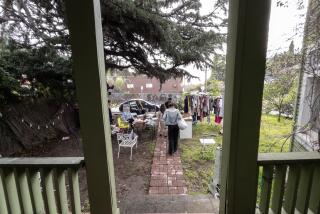NEW! Lightening up a Spanish Revival bungalow
WHEN Alan Smart was a kid, he discovered an old trunk in an antique store and begged his mother to buy it. She refused (after all, he was 10). So young Alan spent $45 from his allowance to purchase the trunk himself.
“I like old-timey things,” Smart says in his retro Hawaiian-print shirt and board shorts, gesturing to his living room filled with restored antique armchairs and vintage California tile tables.
In 1993, the Emmy-nominated director of animation for Nickelodeon’s “SpongeBob SquarePants” bought his 1930s Spanish Revival bungalow in Echo Park. With his partner, artist Michael Uhlenkott, he has spent the last 15 years returning the period vibe to the house, indoors and out, largely through handcrafted details they designed themselves.
Research is a large part of their design process, says Uhlenkott, who previously restored a 1912 Craftsman bungalow in Pasadena. “The house is basically one big conceptual art piece. Whenever we begin a new project, we drive everywhere for ideas, we go to the best flea markets.” In short, he says: “We become obsessed.”
They needed to. When Smart first saw the 1,800-square-foot bungalow, the exterior was painted pink with turquoise trim. Some 1980s “upgrades” reflected the work of previous owners who, thankfully, left intact a hefty wood mantel, an arched interior doorway, built-in bookcases and stucco walls.
Smart was in awe of the ceiling beams. The foot-wide beams, stained black-brown with decorative corbels and stenciling, lent a sense of grandeur. Similar beams, though smaller in scale, graced the dining room.
“The beams were basically the selling point,” Smart says. The $239,000 price tag didn’t hurt either.
He and Uhlenkott proceeded to antiquate the living and dining rooms’ pink walls. They used glazing, rag applications and dry-brush techniques, not to mention layers of ocher, olive and milky-white paint, to create a timeworn golden hue that “resembles the inside of an abbey, one that has lots of candles burning,” Uhlenkott says.
They spent weekends on ladders, hand-painting the living and dining room ceilings. The faded blue was adapted from a color inside the landmark Adamson House in Malibu. Moorish-Gothic stenciling, designed by Uhlenkott, embellishes the spaces between beams. Uhlenkott, trained as a painter and employed as a graphic arts supervisor for the Los Angeles Planning Department, left his artistic signature throughout the house. His decorative tile design, stenciled patterns and hand-painted finishes even appear in the terrace patio and pool area.
For his part, Smart replaced two ordinary double-hung windows flanking the fireplace with rondel-like leaded windows of gold and clear glass. He fabricated them himself in a makeshift basement workshop, using skills gained from a high school job working for a stained-glass supplier. When sunlight pours through the diamonds and circles, the patterns dance across the old hardwood floors and Persian rugs.
Smart searched for hammered and pierced iron chandeliers, ceiling fixtures and wall sconces, in keeping with the Spanish Revival motif. “I have a real thing for antique light fixtures,” he says. Adds Uhlenkott: “The right details are like wearing really nice cuff links.”
The men’s lighthearted sensibility diffuses the traditional somberness of Spanish-style interiors. Spanish Colonial dining chairs are upholstered in celadon mohair. Bauer and Garden City pottery pieces sing in vermilion, turquoise, sunflower yellow, apple green and blue.
The vibrant palette is echoed in intricate cuenca tiles carved by hand and recently installed on steps connecting the living and dining rooms. The pieces were designed by Uhlenkott, and glazed and fired by their friend Diana Mauser of Native Tile & Ceramics in Torrance.
It comes as no surprise that Smart, the guy whose workday is sprinkled with phrases like “Hey, Squidward” and “Have a Krabby Patty,” lets his playful side show in other ways. In a hallway niche where Uhlenkott has painted an Islamic tree of life in gold leaf, you’ll find a 1930s Mexican souvenir figurine of a man in a sombrero. Collectible Monterey furniture from the 1930s in the master bedroom is complemented by a four-poster bed covered with a plaid horse blanket. Slung on the bed post: an old pistol in its holster, similar to one in a framed black-and-white photograph on the dresser showing a 6-year-old Smart decked out like a cowboy.
The home office pays homage to the men’s love of California’s beachcombing and surf culture. “My job has kind of fed into this too,” Smart acknowledges, referring to SpongeBob’s underwater world called Bikini Bottom.
The room is illuminated by a salvaged ship’s light. Bamboo-framed photos of famous midcentury surfers line the walls. A vintage poster from the 1966 surfing documentary “The Endless Summer” was a gift from “SpongeBob” creator Stephen Hillenburg.
Even the kitchen, renovated with yellow and black tile and retro appliances, is accented with quirky, cartoonish Monterey-style art. Smart adapted the colors from the bathroom, where he salvaged the original bath tub and preserved the octagonal-tiled floor. A restored pedestal sink and 1930s milk-glass-and-chrome ceiling light return the room to its original character.
In the bathroom, Smart points to a metal heating vent, embossed with an Art Deco pattern: “That’s why I like old things,” he raves. “Can you imagine someone making that now?”
More to Read
Sign up for our L.A. Times Plants newsletter
At the start of each month, get a roundup of upcoming plant-related activities and events in Southern California, along with links to tips and articles you may have missed.
You may occasionally receive promotional content from the Los Angeles Times.






